Living root bridge
A living root bridge is a type of simple suspension bridge formed of living plant roots by tree shaping. They are common in the southern part of the Northeast Indian state of Meghalaya. They are handmade from the aerial roots of rubber fig trees (Ficus elastica[1][2]) by the Khasi and Jaintia[3] peoples of the mountainous terrain along the southern part of the Shillong Plateau. Most of the bridges grow on steep slopes of subtropical moist broadleaf forest between 50m and 1150m above sea level.[4]
Living root bridge | |
|---|---|
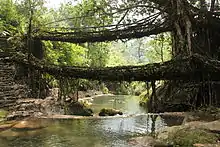 Double living root bridge in East Khasi Hills | |
| Crosses | Creeks |
| Characteristics | |
| Material | Living trees roots tapu and sonu |
| Trough construction | Rocks |
| Total length | over 50 meters |
| Width | over 1.5 meters |
| Design life | up to 500 years |
| History | |
| Architect | Meghalayan |
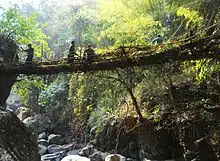
As long as the tree from which it is formed remains healthy, the roots in the bridge can naturally grow thick and strengthen. New roots can grow throughout the tree's life and must be pruned or manipulated to strengthen the bridge. Without active care, many bridges have decayed or grown wild, becoming unusable.[5] Root bridges have also been observed in the Indian state of Nagaland.[6]
Living root bridges have also been created in Indonesia at Jembatan akar on the island of Sumatra, and in the Banten province of Java, by the Baduy people.[7][8]
Methods of creating living root bridges
A living root bridge is formed by guiding the pliable roots of the Ficus elastica tree across a stream or river, and then allowing the roots to grow and strengthen over time until they can hold the weight of a human being. The young roots are sometimes tied or twisted together, and are often encouraged to combine with one another via the process of inosculation. As the Ficus elastica tree is well suited to anchoring itself to steep slopes and rocky surfaces, it is not difficult to encourage its roots to take hold on the opposite sides of river banks.[9][10]
As they are made from living, growing, organisms, the useful lifespan of any given living root bridge is variable. It is thought that, under ideal conditions, a root bridge can last for many hundreds of years. As long as the tree from which it is formed remains healthy, the bridge will naturally self-renew and self-strengthen as its component roots grow thicker.[9][10]
A root bridge can be made in several ways:
Root bridge generation by hand
Some living root bridges are created entirely by manipulating the roots of the Ficus elastica tree by hand, and without the aid of a scaffolding or any other natural or man made materials.[11]
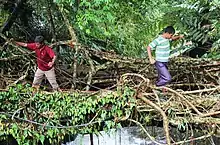
Often, locals using root bridges will make small alterations to them, manipulating young roots as the opportunity presents itself. Because of this, one can say that the development of a living root bridge is very much a social endeavor, and that the structures are perpetual works in progress.
Root bridge generation using a wood or bamboo scaffold
Root bridges are also commonly formed by training young Ficus elastica roots over scaffolds made from wood or bamboo, materials which are abundant in Northeast India. In these instances, the roots are wrapped around the outside of the perishable material. The scaffolds may be replaced many times over the years as the root bridge becomes stronger.[11]

Root bridge generation using Areca Palm trunks
Some living root bridges are grown by training young Ficus elastica roots through the hollowed-out trunks of Areca nut palms. The pliable tree roots are made to grow through betel tree trunks[12] which have been placed across rivers and streams until the figs' roots attach themselves to the other side. The trunks serve to guide the roots, to protect them, and to provide them with nutrients as they decay.[11] Sticks, stones, and other objects are used to stabilize the growing bridge[1] This process can take up to 15 years to complete.[13] This means of creating living root bridges can best be observed near the tourist friendly village of Nongriat.
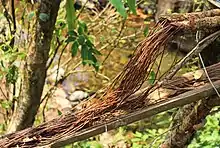
Root bridge generation using conventional structures as scaffolding
Root bridges can also be trained by guiding the young roots of Ficus elastica trees across conventional structures, such as already existing steel wire suspension bridges.[11] As the structure being used as a scaffold is already functional, the problem of the length of time it takes for a root bridge to become functional is here essentially bypassed; the conventional structure can be used until the more sustainable root bridge is sufficiently strong.[11]

Locations
Living root bridges are known to occur in the West Jaintia Hills district and East Khasi Hills district.[3][14] In the Jaintia Hills, examples of Living Root Bridges can be found in and around the villages of Shnongpdeng, Nongbareh, Khonglah, Padu, Kudeng Thymmai and Kudeng Rim.[3] In the East Khasi Hills, living root bridges nearby Cherrapunji now called Sohra are known to exist in and around the villages of Tynrong,[15] Mynteng, Nongriat, Nongthymmai, and around Laitkynsew.[16]
East of Sohra (Cherrapunjee), examples of living root bridges are known to exist in the Khatarshnong region, in and around the villages of Nongpriang, Sohkynduh, Rymmai, Mawshuit, and Kongthong.[17] Many more can be found near Pynursla[14] and around the village of Mawlynnong.
History
The Khasi people do not know when or how the tradition of living root bridges started. The earliest written record of Sohra's (Cherrapunji's) living root bridges is by Lieutenant Henry Yule, who expressed astonishment about them in the 1844 Journal of the Asiatic Society of Bengal.[1]
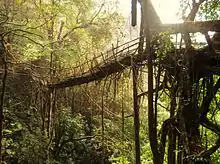
Examples
At over 50 meters in length, the longest known example of a living root bridge[14] is near the small Khasi town of Pynursla, India. It can be accessed from either of the villages of Mawkyrnot or Rangthylliang.
There are several examples of double living root bridges, the most famous being the "Double Decker" root bridge of Nongriat Village, pictured above.
There are three known examples of double bridges with two parallel or nearly parallel spans. Two are in the West Jaintia Hills near the villages of Padu and Nongbareh,[3] and one is in Burma Village, in the East Khasi Hills.[3] There is also a "Double Decker" (or possibly even "Triple Decker") near the village of Rangthylliang, close to Pynursla.[14]
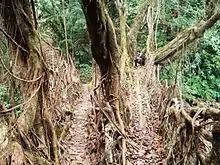
Other examples of living root architecture in Meghalaya
The War Khasis and War Jaintias also make several other kinds of structures out of the aerial roots of rubber trees. These include ladders and platforms.[19] For example, in the village of Kudeng Rim in the West Jaintia Hills, a rubber tree next to a football field has been modified so that its branches can serve as living root bleachers. Aerial roots of the tree have been interwoven in the spaces between several branches so that platforms have been created from which villagers can watch football games.[19]
See also
- Arthur Wiechula
- Axel Erlandson
- Christopher Cattle
- Dawki
- Espalier
- Fab Tree Hab: Living Home of Shaped Trees
- John Krubsack
- Pleaching
- Richard Reames
- Topiary
- Baubotanik
References
- Lewin, Brent (November 2012), "India's living Bridges", Reader's Digest Australia, pp. 82–89, archived from the original on 16 November 2012
- "Living Root Bridge in Laitkynsew India". www.india9.com. Retrieved 22 February 2010.
- Rogers, Patrick A. (2 September 2015). "evenfewergoats: The Undiscovered Living Root Bridges of Meghalaya Part 1: Bridges of The Umngot River Basin". evenfewergoats. Retrieved 4 October 2015.
- Ludwig, Ferdinand & Middleton, Wilfrid & Gallenmüller, Friederike & Rogers, Patrick & Speck, Thomas. (2019). Living bridges using aerial roots of ficus elastica – an interdisciplinary perspective. Scientific Reports. 9. 10.1038/s41598-019-48652-w.
- Middleton, Wilfrid & Habibi, Amin & Shankar, Sanjeev & Ludwig, Ferdinand. (2020). Characterizing Regenerative Aspects of Living Root Bridges. Sustainability. 12. 10.3390/su12083267.
- "Living Root Bridges of Nagaland India – Nyahnyu Village Mon District | Guy Shachar". guyshachar.com. Retrieved 7 September 2017.
- py6unova (13 December 2015). "Baduy Tribe". Ruby Mangunsong. Retrieved 7 September 2017.
- Grundhauser, Eric, WEST SUMATRA, INDONESIA Jembatan Akar, Atlasobscura
- "Cherrapunjee.com: A Dream Place". Cherrapunjee Holiday Resort. Retrieved 7 May 2010.
- "Living Root Bridge". Online Highways LLC. 21 October 2005. Retrieved 7 May 2010.
- "How are Living Root Bridges Made?". The Living Root Bridge Project. 5 May 2017. Retrieved 4 September 2017.
- Vallangi, Neelima. "Indias amazing living root bridges". BBC. Retrieved 27 August 2015.
- Baker, Russ (6 October 2011). "Re-Envisioning Our Environment". Business Insider. Retrieved 24 July 2018.
- Rogers, Patrick A. (14 September 2015). "evenfewergoats: The Undiscovered Living Root Bridges of Meghalaya Part 2: Bridges Near Pynursla". evenfewergoats. Retrieved 4 October 2015.
- Rogers, Patrick A. (26 January 2014). "evenfewergoats: An Unknown Living Root Bridge". evenfewergoats. Retrieved 4 October 2015.
- "Cherrapunjee". Cherrapunjee. Archived from the original on 4 July 2010. Retrieved 4 October 2015.
- Rogers, Patrick A. (24 September 2015). "evenfewergoats: The Undiscovered Living Root Bridges of Meghalaya Part 3: Bridges of the 12 Villages". evenfewergoats. Retrieved 4 October 2015.
- Rogers, Patrick A. (2 September 2015). "evenfewergoats: The Undiscovered Living Root Bridges of Meghalaya Part 1: Bridges of The Umngot River Basin". evenfewergoats. Retrieved 8 October 2015.
- Rogers, Patrick A. (1 October 2015). "evenfewergoats: The Undiscovered Living Root Bridges of Meghalaya Part 4: Living Root Ladders and other uses for living root architecture". evenfewergoats. Retrieved 4 October 2015.
External links
- "The Living Natural Root Bridgew in Meghalaya"
- "Nature’s Marvel: Living Root bridges of Cherrapunji" unbelievable-facts.com
- "Living Root Bridges" also living fig ladders as well as bridges
- "Living Root Bridges of Cherrapunji" at inhabitat.com
- "Living Root Bridges at Cherrapunji In Megahalya" at blotub.com
- " Magic of turning roots into bridges " at familyonthewheels.com
- https://livingrootbridges.com/
- Video clip depicting the training of roots, by the bamboo scaffold method, in an existing root bridge dating to 1840 in the village of Nohwet in East Khasi Hills District, Meghalaya, India. From the BBC's The Travel Show 2017 episode "India: Episode Two".
| Wikimedia Commons has media related to Living bridges. |